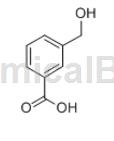Background and overview[1][2]
3-Hydroxymethylbenzoic acid has a wide range of uses, mainly used as organic reagents and pharmaceutical intermediates. The current synthesis method has not been reported in the domestic literature. There are many literatures on the synthesis of this product abroad, but the synthesis method has industrial prospects. It is a reduction method using 3-formylbenzoic acid methyl ester as raw material. The most commonly used reduction method in the literature is the use of chemical reduction reagents such as NaBH4 reduction; there are also literatures using catalytic hydrogenation, but the catalyst used is extremely special and uncommon, and the cost is high.
The disadvantages of the reduction process with chemical reducing agents (such as NaBH4) are: 1) The chemical reducing agent must be added slowly and in batches, and low temperature is required to control the reaction temperature, so the operation is inconvenient and there are safety hazards during the production process ; 2) During post-processing, a large amount of water must be added to quench the reaction, and then an organic solvent is used to extract the water layer. The process is complicated and the amount of waste water is large; 3) The cost is high, and chemical reducing agents are expensive and cannot be recycled. The cost of treating the three wastes is high and puts great pressure on the environment.
The literature reports on the synthesis methods of 3-hydroxymethylbenzoic acid mainly fall into the following two categories: one is the synthesis of 3-hydroxymethylbenzoic acid using m-xylene as raw material, among which the main methods include nitric acid oxidation, potassium iodide and oxygen oxidation. etc., the reactions of this type of method are relatively violent, difficult to control, have many side reactions, and have low reaction yields; the other method is to use m-benzene substituted substances as raw materials to synthesize 3-hydroxymethylbenzoic acid, which mainly includes chlorinated toluene. 3-Hydroxymethylbenzoic acid, m-toluene oxidation method, etc.
This type of method has high raw material prices, high production costs, and is difficult to implement in industrialization. At present, industrial production of m-toluic acid mainly uses the m-xylene air oxidation method, and the m-xylene and cobalt salt catalysts are added to the oxidation tower to preheat , allowing air to carry out reflux and oxidation. This method has shortcomings such as harsh production conditions, complex operations, high equipment requirements, poor reaction effects, low safety factors, and associated pollutants.

3-Hydroxymethylbenzoic acid
Apply[3]
3-Hydroxymethylbenzoic acid is an important organic chemical raw material and an important intermediate for synthetic herbicides and insect repellents. It is also a good developer for color films and can also be used in artificial synthetic flavors and fragrances.
Preparation[2]
Add 51g of 3-formylbenzoic acid methyl ester, 5g of Raney-Ni, and 200g of absolute ethanol into a 500ml hydrogenation high-pressure reaction kettle equipped with mechanical stirring, add hydrogen to bring the pressure to 0.8MPa, and seal and heat to 50°C ( The pressure in the kettle can reach up to 1MPa), and the reaction is stopped when hydrogenation is reached until hydrogen is no longer absorbed (about 5 hours). Raney-Ni was recovered by filtration, and ethanol was recovered under reduced pressure to obtain crude 3-(hydroxymethyl)benzoic acid methyl ester with a dry weight of 53 g, a purity of 96.7%, and a crude product yield of almost 100%. The crude product can be distilled under reduced pressure to obtain 34.3g of white solid, with a purity of 98.2% and a product yield of 98% or more, with a yield of 66.5%. The crude product can also be recrystallized with hexane/ethyl acetate to obtain qualified 3-(hydroxymethyl)benzoic acid methyl ester product with a content greater than 98%. The target product 3-hydroxymethylbenzoic acid is then obtained through hydrolysis reaction.
Method 2:
Put 1.0 mL of m-xylene (≈8 mmol) into a 100 mL round-bottomed flask, and add Cu-MOF (0.30 g), acetonitrile (20 mL), and hydrogen peroxide (30%, 2.0 mL) in sequence, with a density of 1.111 g/mL. , 65mmol), after reacting for 5 hours at 30°C, stop the reaction, cool, filter, and separate through column to obtain 1.06g (isolation yield is about 96%, the main by-product is p-toluic acid) 3-hydroxymethyl benzoic acid.
The column separation steps are as follows: (1) Fill the silica gel column with normal phase silica gel, then stir the filtrate with an appropriate amount of normal phase silica gel and let the filtrate repeatedly adsorb on the silica gel; (2) Rinse with petroleum ether and collect the fractions. Distill out the solvent to obtain m-xylene; (2) Rinse with a 1:1 mixed solvent of petroleum ether and methanol, collect the fractions, and distill the solvent out to obtain 3-methylbenzoic acid; (3) Rinse with methanol, collect the fractions, and distill out The solvent yields 3-hydroxymethylbenzoic acid.
Method 3:
Add 0.1g of catalyst, 0.1g of initiator and 12.0g of acetic acid into the reaction bottle in sequence, and heat the oil bath to 115. C, stir to make it uniform, add 10.6g of m-xylene, dropwise add 17.0g of hydrogen peroxide (condensate water refluxes), complete the dripping, and keep warm for 1 to 5 hours. The reaction was quenched in an ice bath, extracted with dichloromethane (3x5mL), and the component content was detected by HPLC. The crude product was purified by multi-stage series distillation to obtain 10.8g of 3-hydroxymethylbenzoic acid, with a yield of 80% and a purity of 95%;’ HNMR (300MHz, DMSO-dp) δ: 12.90 (s, 1H), 7.76 (dd, J = 6.1Hz, 5.1Hz, 2H), 7.41 (dt, J = 14.8Hz, 7.5Hz, 2H), 2.37 (s ,3H).
Main reference materials
[1] Ruan Lijun, Shang Xinyan, Ge Mei, Chen Daijie, & Zhu Baoquan. (2007). Study on metabolites of plant endophytic fungus hccb00189. Chinese Journal of New Drugs, 16(1), 52-55.
[2] Lu Cuijun, Liu Jianhua, & Du Xiaohua. (2011). Synthesis process of trifloxystrobin. Pesticides, 50(3), 187-191.
[3] Ruan Lijun, Shang Xinyan, Gemei, Chen Daijie, & Zhu Baoquan. (2006). Research on metabolites of plant endophytic fungus HCCB00189. National academic seminar on research and development of innovative drugs and new varieties.

 微信扫一扫打赏
微信扫一扫打赏

